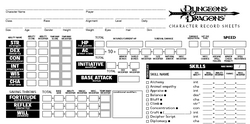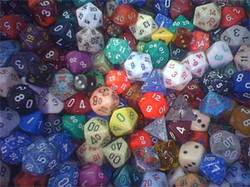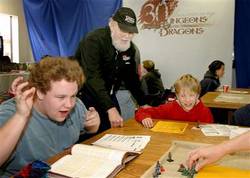Tabletop Role Playing Games (TT)
Tabletop Role Playing Games: The Original RPG
With the release of the game Dungeons & Dragons in the 1970s, the modern age of role playing games was born. Even though military-oriented role playing "games" existed as early as the 19th Century, "D&D" became the flagship for this genre of entertainment.
Benefits of Tabletop Gaming
Tabletop games such as Dungeons & Dragons, GURPs, Rifts, The Call of Cthulu and others require participants to think carefully and plan their actions. In addition, players keep track of "character sheets" which contain anywhere from one to four pages worth of data useful to the playing of their characters.
Players, especially younger ones, of Tabletop RPGs gain experience not only in social interaction and thinking outside of the box, but also in "running numbers" in their heads, calculating and thinking critically about situations to find solutions that the Game Master (GM) might not make obvious.
Tabletop games can have a lasting impact on players sometimes in unique ways. At Deerfield High School (IL), a continuous "campaign" of Dungeons & Dragons began in 1989, and did not end until at least 2002. As older players and Game Masters graduated, they passed their game-books onto younger students, and "retired" characters became fixtures of the game-world that perssited for over a decade.
"You have to be some kind of whiz kid to figure out a sheet like that!" exclaimed one NIU student who wished to remain anonymous, while looking over the sample character sheet below.
Dangers of Tabletop Gaming
Despite education over the decades since Tabletop role playing games first became popular, there have always been those who look down on these games, and the people who play them.
In school settings, students who play games like D&D are often riddiculed by "popular" kids, and in some cases pushed into becoming social outcasts. While this does cause the players of the role playing games to bond closer together, it is still very unhealthy for them.
In addition, many conservative christian groups continue twenty-plus year attacks on role playing games as "satanic" or "promoting polytheism". Following one or two high-profile suicides in the 1980s where the victims families blamed involvement in D&D as the cause, groups like M.A.D&D. (Mothers against Dungeons & Dragons) were formed, risking further social alienation for children and young adults who participate in Tabletop role playing games.
Dice: The Building Blocks of Tabletop Gaming
Above: Almost all Tabletop role playing games employ multi-sided dice to calculate if an action taken in-game is successful, or to calculate how much luck characters have in accomplishing their goals. The "original" set of dice used in Tabletop games consisted of a d4 d6 d8 d10 d12 and d20 (d indicating the number of sides on the dice). Lately, Tabletop game-makers are trying to simplify the mechanics of their systems, and most games in 2007 rely on a single type of dice (most commonly 10- or 20-sided dice).
The Top Portion of a Dungeons & Dragons Character Sheet
A Game for All Ages
Tabletop role playing games are the foundation for all other types of modern role playing games. They can be enjoyed by young children as well as older adults equally. The nature of the game lets the Game Master (GM) control the difficulty and game setting, so it can be customized for the participants.


